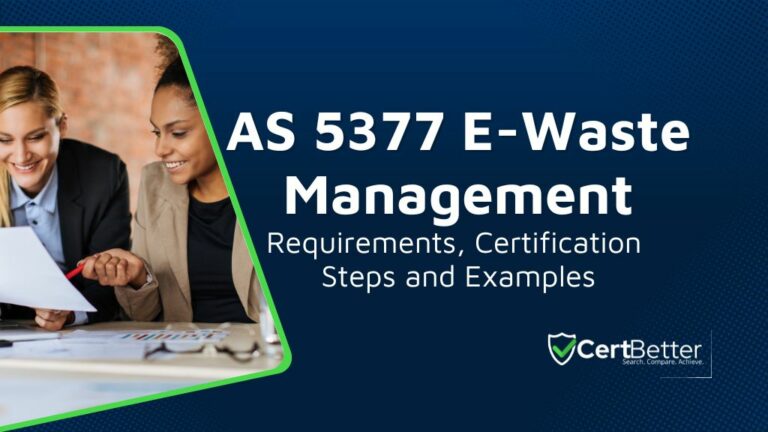AS 5377 E-Waste Management Requirements, Certification Steps and Examples

AS 5377 generally known as E-waste or Electronic Waste Management Standard but if you look at the standard jargons – the title goes like this: “Collection, storage, transport and treatment of end-of-life electrical and electronic equipment,”.
In this guide, we’ll cover the importance of AS 5377, key requirements for certification, and the steps to achieve it, including gap analysis, e-waste management planning, and employee training. We’ll also explore the benefits for businesses, such as improved sustainability, risk reduction, and increased trust, and discuss common challenges and solutions with real-world examples.
What is AS 5377 E-waste Management?
AS 5377 Ewaste Management is an Australian Standard that provides guidelines for the proper management of electronic waste (e-waste). The standard aims to minimize the environmental impact of e-waste by ensuring that it is handled, stored, transported, and treated in an environmentally responsible manner.
Compliance with AS 5377 helps organizations manage e-waste more effectively, reducing the risk of hazardous substances contaminating the environment.
Do You know that you can find AS 5377 E Waste Management Consultants on CertBetter?
Why is AS 5377 E-waste management so Important?
The importance of AS 5377 in e-waste management cannot be overstated. By adhering to this standard, businesses can demonstrate their commitment to environmental sustainability.
For instance, TechCollect, a leading e-waste recycling service in Australia, follows AS 5377 standards to ensure the safe and responsible recycling of electronic products. This not only helps in protecting the environment but also enhances the company’s reputation as an environmentally conscious organization.
Another example is the collaboration between MobileMuster and TES, where AS 5377 certification ensures that mobile phone recycling processes meet high environmental standards.
Implementing AS 5377 also aids in compliance with regulatory requirements, reducing legal risks and fostering consumer trust by showcasing a company’s dedication to responsible e-waste management.
Benefits of AS 5377 E-Waste Management Certification for Businesses
Among so many other benefits, we strongly believe that the following are the best benefits of E-Waste Management Certification in Australia!
1. Enhancing Environmental Responsibility and Sustainability
AS 5377 certification significantly enhances a business’s environmental responsibility and sustainability. By adhering to the guidelines, companies ensure that e-waste is managed in an eco-friendly manner, reducing the negative impact on the environment.
For example, the Australian company TechCollect, which provides e-waste recycling services, follows AS 5377 standards to ensure that electronic waste is processed responsibly. This not only helps in minimizing environmental pollution but also positions the company as a leader in sustainability, attracting eco-conscious customers and investors.
2. Reducing Risks and Liability
Compliance with AS 5377 helps businesses reduce risks and liability associated with improper e-waste management. Mishandling e-waste can lead to significant legal and financial repercussions due to the release of hazardous substances.
For instance, the electronics giant Samsung Australia mitigates these risks by adhering to AS 5377 standards, ensuring that all e-waste is processed in a manner that complies with environmental regulations. This proactive approach reduces the likelihood of fines and legal actions, safeguarding the company’s financial health and reputation.
3. Improving Operational Efficiency and Cost Savings
Adopting AS 5377 standards can lead to improved operational efficiency and cost savings. By standardizing e-waste management practices, businesses can streamline their processes, leading to more efficient resource use and reduced operational costs.
The Australian National University (ANU) experienced such benefits after implementing AS 5377 guidelines. By optimizing their e-waste collection and processing systems, they not only reduced waste but also cut down on disposal costs, achieving significant cost savings while maintaining compliance.
4. Building Trust with Customers and Stakeholders
AS 5377 certification helps build trust with customers and stakeholders by demonstrating a company’s commitment to responsible e-waste management.
For example, Officeworks, a major office supplies retailer in Australia, has gained customer trust by showcasing their adherence to AS 5377 standards in their e-waste recycling programs. This transparency and commitment to environmental stewardship resonate with customers and stakeholders, enhancing the company’s reputation and fostering long-term loyalty.
Key Requirements of AS 5377 Certification
Let’s divide the E-waste Management standard into an easy guide with some examples so we can see how it actually works..
Collection and Storage of Ewaste
The collection and storage of e-waste are critical components of AS 5377 certification. Organizations must ensure that e-waste is collected systematically and stored in a manner that prevents environmental contamination.
For example, the City of Sydney has established designated e-waste collection points where residents can safely dispose of their electronic items. These collection points follow strict guidelines to ensure that e-waste is stored securely, preventing any leakage of hazardous substances.
Another example is the electronics retailer JB Hi-Fi, which partners with e-waste recycling companies to provide collection bins in their stores, making it convenient for customers to recycle their old electronics responsibly.
Treatment and Processing Guidelines
Treatment and processing guidelines under AS 5377 mandate that e-waste is handled using methods that minimize environmental impact. This involves separating hazardous components from non-hazardous ones and ensuring that each type of material is processed appropriately.
For instance, TES, a global leader in e-waste recycling, uses advanced technologies to dismantle electronic devices, recover valuable materials, and safely dispose of hazardous components. Their facilities adhere to AS 5377 standards, ensuring that the treatment processes are both efficient and environmentally friendly.
Additionally, the e-waste recycling company, MRI e-cycle solutions, follows AS 5377 guidelines to process e-waste, recovering precious metals like gold and copper while safely disposing of toxic materials such as lead and mercury.
Transport and Disposal Procedures
The transport and disposal procedures outlined in AS 5377 require that e-waste is transported and disposed of in a way that prevents environmental contamination and ensures the safety of handlers. Companies must use vehicles and containers specifically designed for e-waste transport to prevent leaks and spills.
For example, the Victorian Government’s e-waste policy mandates that e-waste is transported using licensed carriers who comply with AS 5377 standards. This ensures that e-waste is handled safely from the point of collection to the final disposal site.
Another example is Sims Recycling Solutions, which follows stringent transport protocols to move e-waste from collection points to their processing facilities, ensuring compliance with AS 5377 throughout the entire logistics chain.
Documentation and Reporting Requirements
Documentation and reporting requirements are essential for maintaining transparency and accountability in e-waste management. AS 5377 requires organizations to keep detailed records of e-waste quantities, types, and handling methods. This includes tracking e-waste from the point of collection through treatment and final disposal.
For instance, MobileMuster, Australia’s leading mobile phone recycling program, maintains comprehensive records of all collected and processed mobile phones. These records are crucial for auditing purposes and for demonstrating compliance with AS 5377 standards.
Another example is the Clean Up Australia initiative, which documents the amounts and types of e-waste collected during their clean-up events, providing valuable data for reporting and improving future e-waste management efforts.
Steps to Achieve AS 5377 E Waste Management Certification
1. Initial Assessment and Gap Analysis
The first step to achieving AS 5377 certification is conducting an initial assessment and gap analysis. This involves evaluating the current e-waste management practices of an organization to identify areas that do not meet AS 5377 standards.
For example, the City of Melbourne conducted a comprehensive gap analysis of their e-waste collection and disposal processes, identifying deficiencies in storage practices and documentation. This assessment provided a clear roadmap for improvements needed to comply with AS 5377, ensuring a systematic approach to certification.
2. Developing an E-waste Management Plan
Once the gaps are identified, the next step is developing an e-waste management plan tailored to address those deficiencies and meet AS 5377 requirements. This plan should outline procedures for the collection, storage, transport, and processing of e-waste.
For instance, the electronics retailer Officeworks developed a detailed e-waste management plan in partnership with an e-waste recycling company, ensuring all processes from customer drop-off to final recycling adhered to AS 5377 standards. This plan included protocols for handling hazardous components and measures to maximize material recovery.
3. Employee Training and Awareness Programs
Employee training and awareness programs are crucial for successful implementation of the e-waste management plan. Staff must be educated on the importance of AS 5377 standards and trained in specific procedures for handling e-waste.
For example, the Australian National University (ANU) launched a training program for its facilities management team, covering safe e-waste handling practices and compliance with AS 5377. These training sessions ensured that all employees understood their roles in maintaining certification standards, fostering a culture of environmental responsibility.
4. Internal Audits and Continuous Improvement
The final step involves conducting regular internal audits and fostering continuous improvement. Internal audits help ensure ongoing compliance with AS 5377 standards and identify areas for enhancement.
For instance, the e-waste recycling company SUEZ conducts quarterly audits of its operations to verify adherence to AS 5377. These audits are complemented by continuous improvement initiatives, such as adopting new technologies for better material recovery and implementing feedback from staff to refine procedures.
This approach ensures that the organization not only achieves but also maintains AS 5377 certification over time.
Challenges in Implementing AS 5377 Standards
As with any other international or Australian standards, the AS 5377 E-Waste Management comes with some hurdles. Let’s see the most common challenges companies often face..
Common Obstacles and How to Overcome Them
Implementing AS 5377 standards can present several challenges. Common obstacles include the initial cost of setting up compliant systems, training employees, and updating infrastructure. For instance, small businesses might struggle with the financial investment required to meet AS 5377 standards.
Overcoming these challenges involves a strategic approach, such as seeking government grants or subsidies designed to support environmental initiatives. Additionally, businesses can collaborate with certified e-waste recycling companies to share the burden of compliance costs and expertise.
Case Studies: Successful AS 5377 Implementation
Several businesses have successfully implemented AS 5377 standards, providing valuable case studies. One notable example is SUEZ, a global waste management company that has integrated AS 5377 guidelines into their operations in Australia.
SUEZ has developed comprehensive e-waste management protocols that include regular audits, employee training, and advanced recycling technologies. Another success story is the partnership between MobileMuster and TES, where both organizations have aligned their e-waste management practices with AS 5377 standards.
This collaboration has led to improved recycling rates and reduced environmental impact, demonstrating the tangible benefits of certification.
Final Thoughts
In conclusion, AS 5377 E-Waste Management Certification offers numerous benefits for businesses, including enhanced sustainability, reduced risks, improved efficiency, and increased trust. While there are challenges in implementation, strategic planning and collaboration can help businesses overcome these obstacles and achieve successful certification. Real-world examples like TechCollect, Samsung Australia, ANU, Officeworks, SUEZ, and MobileMuster highlight the positive impact of adhering to AS 5377 standards on both environmental and business performance.
- Last updated: June 9, 2024
- CertBetter
Our community of compliance professionals and ISO experts is ready to provide you with insightful answers and practical solutions. Join the discussion now!
- Recommended Reads
- 33 reads
-
Frequently Asked Questions
Understanding ISO Terminology: Guide to Important Terms and Concepts
No posts found
ResetConnect with ISO Certification Consultants
CertBetter makes it easy to find ISO certification consultants and compliance professionals from around the globe.

